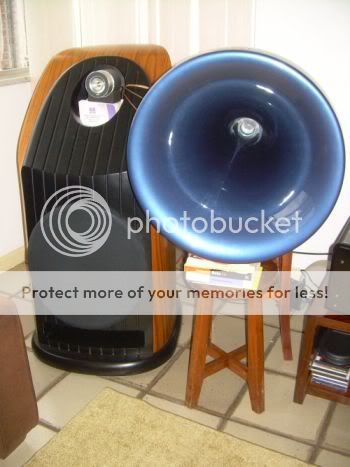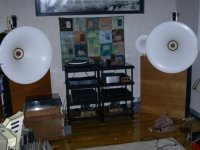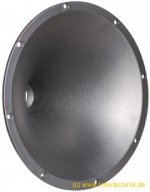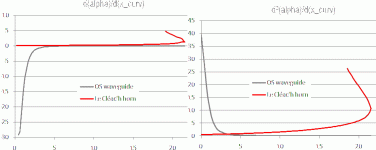Hello sqlkev,
Tthe B&C drivers are quite good. I know a bit the DE250 which must be used above 1000Hz min and which is quite smooth sounding.
A cutoff of 400Hz for the horn will be a bit high for the Adastra driver. Remember that it should be better to use a 400Hz horn above 800Hz...
I think that there is no vertical plot for the J322 because Cyrille Pinton found that the response in the vertical plane was the same as in the horizontal (due to the axial symetry).
Best regards from Paris, France
Jean-Michel Le Cléac'h
Tthe B&C drivers are quite good. I know a bit the DE250 which must be used above 1000Hz min and which is quite smooth sounding.
A cutoff of 400Hz for the horn will be a bit high for the Adastra driver. Remember that it should be better to use a 400Hz horn above 800Hz...
I think that there is no vertical plot for the J322 because Cyrille Pinton found that the response in the vertical plane was the same as in the horizontal (due to the axial symetry).
Best regards from Paris, France
Jean-Michel Le Cléac'h
sqlkev said:
that's just about the perfect bandwidth i was looking for 🙂
although a 200hz horn
What do you think of the B&C compression drivers?
I plan to use a set on the tweeter horns. I don't need the extra high efficiency since the subs will probably be dipole using the eminence alpha 15s with a pair per side.
wow, i'm quite impressed with the linear responses of the J322
(the vertical plots are missing from the .gif though)
would it help at all if i use steep xover filter to highpass it?
a 200hz horn is quite huge and I'm not sure if i'm up for such project just yet
your reasoning for the lack of vertical plots makes perfect sense 🙂
i'm looking at this de10 to try out just for fun (it's cheap enough like the midrange driver you recommended)
http://www.prosoundservice.com/m9_view_item.html?m9:item=B&C-DE10
a 200hz horn is quite huge and I'm not sure if i'm up for such project just yet

your reasoning for the lack of vertical plots makes perfect sense 🙂
i'm looking at this de10 to try out just for fun (it's cheap enough like the midrange driver you recommended)
http://www.prosoundservice.com/m9_view_item.html?m9:item=B&C-DE10
sqlkev,
It is possible to conduct measurements and compare gainst sims. I have done it for one design so far, and preparing to look into the second one. However, it is important to understand that sim conditions are different from the measurement conditions, also certain sim settings will effect how clean the sim is. So sims will probably never be accurate enough to be exactly like the measurements, but if we understand the limitations of sims, it can be a good reference for a first cut. It can also be used to find out the more probable causes of problems in a design. Bear in mind that sims are used across various industries significantly as a cost effective measure to reduce risk. In high budget projects, sim models are adjusted extensively to be more accurate using measurement data, I doubt any audio company will do this because the returns are not justified. The technology is there, but not the budget to make it happen.
It is possible to conduct measurements and compare gainst sims. I have done it for one design so far, and preparing to look into the second one. However, it is important to understand that sim conditions are different from the measurement conditions, also certain sim settings will effect how clean the sim is. So sims will probably never be accurate enough to be exactly like the measurements, but if we understand the limitations of sims, it can be a good reference for a first cut. It can also be used to find out the more probable causes of problems in a design. Bear in mind that sims are used across various industries significantly as a cost effective measure to reduce risk. In high budget projects, sim models are adjusted extensively to be more accurate using measurement data, I doubt any audio company will do this because the returns are not justified. The technology is there, but not the budget to make it happen.
Hello sqlkev,
a steep crossover will not help too much. The main problem I see when using a driver in a frequency interval very near of the acoustical cut-off frequency of the horn is the voice seeming to come from very far inside the horn. This can be explained by the group delay that rises very fast when the frequency decreases under 2.Fc . Imagine the fundamental of the voice or of an instrument seeming coming 1 meter or more beneath its harmonics, this lead to a strange effect (a strain in the image of the sound source).
A square horn like the one built by my friend Nicolas Davidenko is easy to build using the profile of the cuts you have to perform in a plywood sheet as given by my spreadsheet.
http://ndaviden.club.fr/index.html
Best regards from Paris, France
Jean-Michel Le Cléac'h
a steep crossover will not help too much. The main problem I see when using a driver in a frequency interval very near of the acoustical cut-off frequency of the horn is the voice seeming to come from very far inside the horn. This can be explained by the group delay that rises very fast when the frequency decreases under 2.Fc . Imagine the fundamental of the voice or of an instrument seeming coming 1 meter or more beneath its harmonics, this lead to a strange effect (a strain in the image of the sound source).
A square horn like the one built by my friend Nicolas Davidenko is easy to build using the profile of the cuts you have to perform in a plywood sheet as given by my spreadsheet.
http://ndaviden.club.fr/index.html
Best regards from Paris, France
Jean-Michel Le Cléac'h
sqlkev said:would it help at all if i use steep xover filter to highpass it?
a 200hz horn is quite huge and I'm not sure if i'm up for such project just yet :cannot be:
hmmm....a set of 200hz horns 
btw
what's the accuracy/precision are we talking about in making our own horns here? 1+-mm the whole profile or it's only crucial at the throat and outer lip?

btw
what's the accuracy/precision are we talking about in making our own horns here? 1+-mm the whole profile or it's only crucial at the throat and outer lip?
hmmm....a set of 200hz horns
To work well from ca 200hz the horns will need to to be almost 100*100cm😎 ! If you mount them against the sidewalls you can probaly slice at least 30cm off from the "wall-side" of the horns. Attached is an image of a Swedish system with sidewallmounted Lowthers working from 150hz up.
An externally hosted image should be here but it was not working when we last tested it.
Jmmlc said:Those horns are "JBL 2380A", "Beyma TD-400", and a Le Cléac'h horn "Musique-concrète J322".
Thanks very much for that, JM. A good read. It's easy to see that the big, round horn beams more than the more complex JBL & Beyma. And Mr. Pinton points this out in his text.
Otherwise the big horn does quite well. It looks very clean.
I've noticed that very "pure form" horns tend to beam badly. That's why so much work was done on the CD horns. But the purer, simpler shapes always sound better, sound less colored. At least if the beaming is taken into account.
Is that always going to be true of a horn without the CD "tricks"?
After finishing some draft measurements of the horn/guide with the LeCleach type expansion with OS type diffraction throat, I though it would be interesting to look at all three horn/guide measurements together. Last made is on top.
It's going to be interesting trimming the last one a bit.
An externally hosted image should be here but it was not working when we last tested it.
It's going to be interesting trimming the last one a bit.
And a look at sims vs measurements. Note some trends are similar yet there are some differences.
An externally hosted image should be here but it was not working when we last tested it.
soongsc said:
LeCleach type expansion with OS type diffraction throat,
That I dont understand 🙄
Hard to see what is what in your measurements
revintage said:
To work well from ca 200hz the horns will need to to be almost 100*100cm😎 ! If you mount them against the sidewalls you can probaly slice at least 30cm off from the "wall-side" of the horns. Attached is an image of a Swedish system with sidewallmounted Lowthers working from 150hz up.
An externally hosted image should be here but it was not working when we last tested it.
can't possibly mount them against the walls
the width of my room is about 18ft wide
the square lecleach horn is an interesting approach
is there a page with more details on how to make such horn??
soongsc,
can you tell us which is which?
so these were real measurements? which driver did you use on those horn/waveguide??
In the Geddes thread, I started out with doing a large elliptic horn/guide with OS expansion throat but with hyperbolic lip, then a small axisymmetric one with OS expansion throat and hyperbolic lip, last was using an OS expansion throat with LeCleach expansion lip. Hard to explain without getting into too much detail drawings. But the original idea was to find a compromise between CD and HOMs without using foam, and it seemed not one simple curve can accomplish this. So I'm using blends of curvature to see what is optimum for a specific size and driver.tinitus said:
That I dont understand 🙄
Hard to see what is what in your measurements
I was showing the measurements of the three in the order putting the last made horn/guide first and the first made last. All cover 45 deg in 7.5 deg increments.
sqlkev
see these two homepages
http://collignon.chez-alice.fr/PAVILLON.htm
http://ndaviden.club.fr/pavillon/fabrication/fabrication1.html
Jean Michel
some time ago i made a tractrix horn with 25" ( 60cm ) mouth diameter, ( see picture below ) and tested it with the Radian 950Pb, crossing quit low, at 300hz/12db. Performance was tremendous, despite many say, to use a horn driver below Fs increases distortion dramatically. I didn't hear this.
I also agree on your observation, that spacial perception with LeCleac'h horn is excellent, better than with tractrix horns. I would wonder, how comes......
i am curious to know your listening impressions of the setup, you will be listening this weekend.
regarding horn driver for midbass duty:
do you know this
Klangfilm - Siemens 6S ELA 3272 / T8 vintage driver ? ( see last post ) ?
http://www.audiovoice-acoustics.com/forum/showthread.php?t=66&page=5
what is remarkable, is that it uses a paper cone, and is similarly built like the RCA field coil 1428. It is not expensive, when
( rarely ) offered at ebay. I would wonder how it sounds.
Angelo

see these two homepages
http://collignon.chez-alice.fr/PAVILLON.htm
http://ndaviden.club.fr/pavillon/fabrication/fabrication1.html
I used to listen a 2 inch compression driver on a large Avant Garde modified tractrix horn (with a throat adapter) and it was excellent, even if the Le Cléac'h horn succeed in giving a better 3D sound image.
Jean Michel
some time ago i made a tractrix horn with 25" ( 60cm ) mouth diameter, ( see picture below ) and tested it with the Radian 950Pb, crossing quit low, at 300hz/12db. Performance was tremendous, despite many say, to use a horn driver below Fs increases distortion dramatically. I didn't hear this.
I also agree on your observation, that spacial perception with LeCleac'h horn is excellent, better than with tractrix horns. I would wonder, how comes......
i am curious to know your listening impressions of the setup, you will be listening this weekend.
regarding horn driver for midbass duty:
do you know this
Klangfilm - Siemens 6S ELA 3272 / T8 vintage driver ? ( see last post ) ?
http://www.audiovoice-acoustics.com/forum/showthread.php?t=66&page=5
what is remarkable, is that it uses a paper cone, and is similarly built like the RCA field coil 1428. It is not expensive, when
( rarely ) offered at ebay. I would wonder how it sounds.
Angelo

This is Azura 204 Hz Le Cleach horn on the top of a K-Horn (lowther Dx4). 10.5 ' wall to wall. And a small 550 Hz behind it. Room is to small for such setup therefore I sold Lowther and now use Azura as a low mid horn on the floor untill I build proper midbass. I stucked temporarily Tad Tm 1201 to see what it does (it starts to turn in at 300hz) Nothing is optimized (as usual😉 but I'm telling you that midbass, low mid horn is essential for horn playback.
The question would be if I get the same spatial,relaxed presentation with 80 Hz Hypex (0.7 quarter space) horn with 7" throat in a 80-500hz range??
The question would be if I get the same spatial,relaxed presentation with 80 Hz Hypex (0.7 quarter space) horn with 7" throat in a 80-500hz range??
Attachments
Contour comparison of the last two horn/guides. Shallow contour is top measured curve.soongsc said:After finishing some draft measurements of the horn/guide with the LeCleach type expansion with OS type diffraction throat, I though it would be interesting to look at all three horn/guide measurements together. Last made is on top.
An externally hosted image should be here but it was not working when we last tested it.
It's going to be interesting trimming the last one a bit.
An externally hosted image should be here but it was not working when we last tested it.
Now, if I actually curled the lip back, what change can I expect?
soongsc said:
Now, if I actually curled the lip back, what change can I expect?
Well, Jean Michell has previously said that the main differense in his horns really are the curved mouth, and is what works effectively, the rest should be pretty ordinary stuff
But it seems that you change both length and curvature as well, which could be an issue
This cheap waveguide below ought to be easy to modify with throath smoothing and curved mouth, or at least smooth transition to baffle
Might even be used with small fullrange
Attachments
Yes, and I am interested in understanding how it effects sound and how we can visualize it through various tests and sims. But first I will spend more time to obtain s specific dispersion pattern that is sort of in between a LeCleach horn and an OS wave guide.tinitus said:
Well, Jean Michell has previously said that the main differense in his horns really are the curved mouth, and is what works effectively, the rest should be pretty ordinary stuff
But it seems that you change both length and curvature as well, which could be an issue
This cheap waveguide below ought to be easy to modify with throath smoothing and curved mouth, or at least smooth transition to baffle
Might even be used with small fullrange
The reason why I change both length and curve is to see what can be accomplished in a fixed form factor. But more important is that although I show only the latter half of the horn/guide for dispersion study, the other half to the diagram is also different which effects other aspects of performance. Notice change in notch shape and location in the measured curves.
The problems I think using full range in horn/guides is that the radiation pattern changes throughout the frequency, thus causing a more complicated wave front, when coupled with a horn/guide, can cause additional coloration to the sound.
Traditionally, people consider drivers and horn/guide seperately, I think a horn/guide should be designed for a specific driver only for optimum performance.
Hello Angelo,
Ronny Weissman uses quite the same set up as you: a Vitavox S2 compression driver mounted on a Le Cléac'h horn built by Marco Henry (Musique Concrète). Please read,
http://goodsoundclub.com/Forums/ShowPost.aspx?postID=4593#4593
Few things he says about the high frequencies may be related to some characteristics of the driver.
For my part I only keep the best of his message:
"the sound is fantastic. It is the very stringy cellos with appropriate dynamics, vocals have plenty of subtlety, I really like the sound."
Best regards from Paris.
Jean-Michel Le Cléac'h
[
angeloitacare said:The best i have come up until now is my actual configuration, using in the midrange a LeCleac'h horn, and Vitavox S2 driver. While it does reproduce most music incredibly well, beeing it a real pleasure and relaxing, to spend time, listening to music, there are other things, that i wish, it would do better. Namely voices, specially female voices, have the tendency, sometimes to sound irritating...
Ronny Weissman uses quite the same set up as you: a Vitavox S2 compression driver mounted on a Le Cléac'h horn built by Marco Henry (Musique Concrète). Please read,
http://goodsoundclub.com/Forums/ShowPost.aspx?postID=4593#4593
Few things he says about the high frequencies may be related to some characteristics of the driver.
For my part I only keep the best of his message:
"the sound is fantastic. It is the very stringy cellos with appropriate dynamics, vocals have plenty of subtlety, I really like the sound."
Best regards from Paris.
Jean-Michel Le Cléac'h
[
Hello,
According to Earl Geddes the production of HOMs is related to the derivative of the profile of the waveguide (or horn) and more precisely to the second derivative.
You'll find in attached file compared curves for the OS waveguide and a Le Cléac'h horn showing along the axial distance, the evolution of the first and second derivative of the slope angle of the profile versus the curvilinear distance to throat.
As we can see both 1st and 2nd derivative have greater absolute maximum values near the throat with the OS waveguide when for the Le Cléac'h it is at the mouth.
For what its worth... ;-)
Best regards from Paris, France
Jean-Michel Le Cléac'h
According to Earl Geddes the production of HOMs is related to the derivative of the profile of the waveguide (or horn) and more precisely to the second derivative.
You'll find in attached file compared curves for the OS waveguide and a Le Cléac'h horn showing along the axial distance, the evolution of the first and second derivative of the slope angle of the profile versus the curvilinear distance to throat.
As we can see both 1st and 2nd derivative have greater absolute maximum values near the throat with the OS waveguide when for the Le Cléac'h it is at the mouth.
For what its worth... ;-)
Best regards from Paris, France
Jean-Michel Le Cléac'h
Attachments
J-M,
Been following along with this thread.
I am unsure of some of the things I am seeing and reading.
Regarding a "lip" or "radius" that extends past the point of being perpendicular to the main axis of the horn...
Are you saying that the lip of the horn is best terminated by a large fat lip of considerable size? Did I see a curve where the outer edge of the lip is brought all the way back around to the rear of the horn?
If this is correct, what role does are area that intuitively appears to be unrelated physically to the wave that is launched have?
I think I am seeing that there is a suggestion that terminating the horn to a flat large ("infinite"?) baffle has benefits... are we talking after a curve/radius of some dimension has reached the point of being tangent to the plane that is perpendicular to the main horn axis? Does a larger flat baffle "work" with a "lip" that extends back past this plane (that being the "front of the mouth" where the curving horn mouth meets it)?
And, are we then saying that almost any horn expansion might then benefit from an arbitrary "lip" of sufficient dimension? And, then what is the relationship between the "lip" dimension and frequency/wavelength?
Hope I am being clear enough...
_-_-bear
Been following along with this thread.
I am unsure of some of the things I am seeing and reading.
Regarding a "lip" or "radius" that extends past the point of being perpendicular to the main axis of the horn...
Are you saying that the lip of the horn is best terminated by a large fat lip of considerable size? Did I see a curve where the outer edge of the lip is brought all the way back around to the rear of the horn?
If this is correct, what role does are area that intuitively appears to be unrelated physically to the wave that is launched have?
I think I am seeing that there is a suggestion that terminating the horn to a flat large ("infinite"?) baffle has benefits... are we talking after a curve/radius of some dimension has reached the point of being tangent to the plane that is perpendicular to the main horn axis? Does a larger flat baffle "work" with a "lip" that extends back past this plane (that being the "front of the mouth" where the curving horn mouth meets it)?
And, are we then saying that almost any horn expansion might then benefit from an arbitrary "lip" of sufficient dimension? And, then what is the relationship between the "lip" dimension and frequency/wavelength?
Hope I am being clear enough...
_-_-bear
- Home
- Loudspeakers
- Multi-Way
- Jean Michel on LeCleac'h horns


